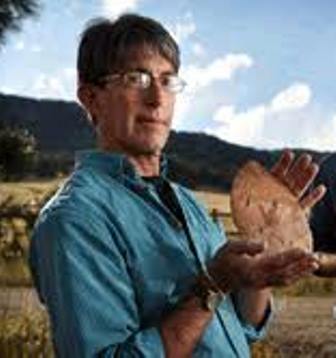Affiliation: University of Colorado, Boulder

Douglas Bamforth is Professor of Anthropology at the University of Colorado, Boulder:
“I am an archaeologist who works mainly on the Great Plains; I have also worked in the Colorado mountains, coastal California, the California desert, the Great Basin, Germany, and Ireland. I have a major technical interest in the study of how ancient people made and used stone tools. My research has focused on how human use of the Plains landscape responded to long-term environmental change during the Paleoindian period (from roughly 11,000 to 8000 BC); recently, my interests have shifted towards the archaeology of farmers on the central and northern Plains during the last 1000 years. I am currently involved in a long-term field project that examines the archaeology of the Ceramic Period along the Pine Ridge in northwestern Nebraska.”
Historians, geographers, and archaeologists have argued for over a century that the American West begins at the 100th meridian, which is said to define the boundary between the arid west and the well-watered east. West of the 100th meridian, indigenous people were hunters and gatherers; east of it, they were farmers. The archaeology of the Great Plains has always complicated this argument: since the 1930s, we have known about indigenous Plains farmers in southwestern Nebraska. This talk presents new (and some old) evidence of related Plains farmers almost on the Nebraska/Wyoming border. During the late 12th century, people grew maize and manufactured Plains Village pottery at the King site near Chadron, Nebraska. The archaeology of this community mixes together elements of western Plains hunter-gatherers and eastern Plains farmers and the people who lived there may have been western Plains people in transition from hunting and gathering to food production.
Archaeology wonders at great length about how people invented farming but often takes the subsequent spread of farming more or less for granted. Globally, we know that farming spread in many ways. Sometimes farmers migrated into hunter-gatherer land and took it; other times they traded and married with hunter-gatherers over longer periods before farming became dominant. In every case, though, the transformation from hunting and gathering happened knowledgably, involving groups who must have interacted, eaten each other’s foods, and spoken together. This talk explores this problem on the central Great Plains, where evidence for the earliest (12th century) maize farmers knew the great Mississippian center of Cahokia. The first pulse of maize farming in eastern Kansas and adjacent areas shows a mix of Cahokian and indigenous architecture and material culture; people had to have moved back and forth. These earliest groups also shifted from collective to individual burial, suggesting significant changes in the way people symbolized their community. Over a century, though, maize farming spread more widely without the trappings of Mississippian society, as other Midwestern agriculturalists spread into the region.
Plains farmers settled at the Lynch site in northeastern Nebraska during the latter decades of the 13th century, in the midst of a wave of social change and dislocation across the mid-continent as Cahokia collapsed and drought spread widely over much of North America. In contrast to the small homesteads on the central Plains prior to this time, Lynch covers nearly 200 acres, suggesting a community bigger than anything that had existed in the region before. Potters at the site made classic Plains vessels and classic midwestern Oneota vessels in households that were nearly side-by-side and mixed these styles together on other pots. This lecture addresses the social changes at work in the mid-continent at this time along with the history of work at Lynch from the 1930s to the present, including geophysical prospecting and excavation in the last two years. Viewed in the context of the Plains as a whole, the changes at Lynch and nearby sites represent a sea-change in social formations and likely mark the appearance of the modern Pawnee and Arikara nations.
We often divide native North America into well-defined “culture areas” that correspond roughly to environmental/physiographic areas (the Northwest Coast, the Great Plains, etc.). The Southwest, extending from Durango (Colorado) to Durango (Mexico) and from Las Vegas (Nevada) to Las Vegas (New Mexico) is one of these. The earliest Europeans who described the region saw a vivid natural and cultural boundary that echoes down to the present in archaeology and the popular imagination, from Plains grasslands to Southwestern mountains, from bison hunters to maize farmers. The archaeology of the Colonial era shows us this boundary just as Europeans like Coronado saw it, with distinctive material culture in the Plains and Southwest and highly structured economic interaction between them. The archaeology of more ancient times, though looks very different from this: distinctively Southwestern architecture and material culture extended far out onto the grasslands, often with no evidence of interaction with Plains people. From the 13th through the arrival of the Spanish in the early 16th centuries, economic and social relations between the Plains and the Southwest varied from trade to warfare, culminating in the disappearance of Southwestern people from the Southern Plains a generation or so before Europeans arrived.